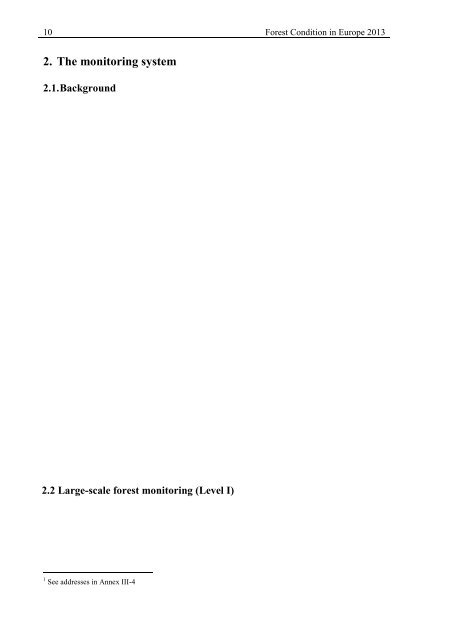Forest Condition in Europe - ICP Forests
Forest Condition in Europe - ICP Forests
Forest Condition in Europe - ICP Forests
Create successful ePaper yourself
Turn your PDF publications into a flip-book with our unique Google optimized e-Paper software.
10 <strong>Forest</strong> <strong>Condition</strong> <strong>in</strong> <strong>Europe</strong> 2013<br />
2. The monitor<strong>in</strong>g system<br />
2.1. Background<br />
Mart<strong>in</strong> Lorenz, Oliver Granke 1<br />
<strong>Forest</strong> monitor<strong>in</strong>g <strong>in</strong> <strong>Europe</strong> has been conducted for 27 years accord<strong>in</strong>g to harmonised methods<br />
and standards by the International Cooperative Programme on Assessment and Monitor<strong>in</strong>g<br />
of Air Pollution effects on <strong>Forest</strong>s (<strong>ICP</strong> <strong>Forest</strong>s) of the Convention on Long-range Transboundary<br />
Air Pollution (CLRTAP) under the United Nations Economic Commission for <strong>Europe</strong><br />
(UNECE). The monitor<strong>in</strong>g results meet the scientific <strong>in</strong>formation needs of CLRTAP for<br />
clean air policies under UNECE. Accord<strong>in</strong>g to its strategy for the years 2007 to 2015, <strong>ICP</strong><br />
<strong>Forest</strong>s pursues the follow<strong>in</strong>g two ma<strong>in</strong> objectives:<br />
1. To provide a periodic overview of the spatial and temporal variation of forest condition<br />
<strong>in</strong> relation to anthropogenic and natural stress factors (<strong>in</strong> particular air pollution)<br />
by means of <strong>Europe</strong>an-wide (transnational) and national large-scale representative<br />
monitor<strong>in</strong>g on a systematic network (monitor<strong>in</strong>g <strong>in</strong>tensity Level I).<br />
2. To ga<strong>in</strong> a better understand<strong>in</strong>g of cause-effect relationships between the condition of<br />
forest ecosystems and anthropogenic as well as natural stress factors (<strong>in</strong> particular<br />
air pollution) by means of <strong>in</strong>tensive monitor<strong>in</strong>g on a number of permanent observation<br />
selected <strong>in</strong> most important forest ecosystems <strong>in</strong> <strong>Europe</strong> (monitor<strong>in</strong>g <strong>in</strong>tensity<br />
Level II).<br />
The complete methods of forest monitor<strong>in</strong>g by <strong>ICP</strong> <strong>Forest</strong>s are described <strong>in</strong> detail <strong>in</strong> the<br />
“Manual on methods and criteria for harmonised sampl<strong>in</strong>g, assessment, monitor<strong>in</strong>g and analysis<br />
of the effects of air pollution on forests” (<strong>ICP</strong> <strong>Forest</strong>s 2010). For many years forest monitor<strong>in</strong>g<br />
accord<strong>in</strong>g to the <strong>ICP</strong> <strong>Forest</strong>s Manual was conducted jo<strong>in</strong>tly by <strong>ICP</strong> <strong>Forest</strong>s and the <strong>Europe</strong>an<br />
Commission (EC) based on EU - cof<strong>in</strong>anc<strong>in</strong>g under relevant Council and Commission<br />
Regulations. The monitor<strong>in</strong>g results are also delivered to processes and bodies of <strong>in</strong>ternational<br />
forest and environmental policies other than CLRTAP, such as <strong>Forest</strong> <strong>Europe</strong> (FE), the Convention<br />
on Biological Diversity (CBD), the UN-FAO <strong>Forest</strong> Resources Assessment (FRA),<br />
and EUROSTAT of EC. In order to better meet the new <strong>in</strong>formation needs with respect to<br />
carbon budgets, climate change, and biodiversity, the forest monitor<strong>in</strong>g system was further<br />
developed <strong>in</strong> the years 2009 to 2011 with<strong>in</strong> the project “Further Development and Implementation<br />
of an EU-level <strong>Forest</strong> Monitor<strong>in</strong>g System” (FutMon) under EU-cof<strong>in</strong>anc<strong>in</strong>g. The follow<strong>in</strong>g<br />
chapters describe briefly the selection of sample plots and the surveys on the revised<br />
Level I and Level II monitor<strong>in</strong>g networks.<br />
2.2 Large-scale forest monitor<strong>in</strong>g (Level I)<br />
The large-scale forest monitor<strong>in</strong>g grid consists of more than 7500 plots. The selection of Level<br />
I plots is with<strong>in</strong> the responsibility of the participat<strong>in</strong>g countries, but the density of the plots<br />
should resemble that of the previous 16 x 16 km grid. For this reason, the number of plots <strong>in</strong><br />
each country should be equal to the forest area of the country (<strong>in</strong> km 2 ) divided by 256.<br />
1 See addresses <strong>in</strong> Annex III-4
















